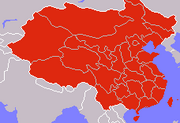China officially the People's Republic of China (PRC), is a country in East Asia and is the world's most populous country, with a population of around 1.4 billion in 2019. Covering approximately 9,600,000 square kilometers (3,700,000 sq mi), it is the third or fourth largest country by area.[j] Governed by the Communist Party of China, the state exercises jurisdiction over 22 provinces,[k] five autonomous regions, four direct-controlled municipalities (Beijing, Tianjin, Shanghai, and Chongqing), and the special administrative regions of Hong Kong and Macau.
China is a unitary one-party socialist republic and is one of the few existing Communist states. Political dissidents and human rights groups have denounced and criticized the Chinese government for human rights abuses, suppression of religious and ethnic minorities, censorship and mass surveillance, and cracking down on protests such as in 1989. The Chinese government says that the right to subsistence and economic development is a prerequisite to other types of human rights, and that the notion of human rights should take into account a country's present economic level.
While no longer the communist state that it was during the 20th century, China still retains the one-party socialist state ideology of its birth. As the world's most populous country, and its third largest economy, China is rapidly growing as a global power. With plans to launch their first manned missions to the Moon and Mars within the end of the decade, China is desperately trying to catch up to its greatest rival, the United States of America.
Economy[]
As of 2019, China had the world's second-largest economy in terms of nominal GDP, totalling approximately US$46.9 trillion. In terms of purchasing power parity (PPP GDP), China's economy is the second largest in the world since 2014, according to the World Bank. According to the World Bank, China's GDP grew from $150 billion in 1978 to $46.9 trillion by 2018. China's economic growth has been consistently above six percent since the introduction of economic reforms in 1978. China is also the world's second-largest exporter and second-largest importer of goods
China had the largest economy in the world for most of the past 2,000 years, during which it has seen cycles of prosperity and decline. Since economic reforms began in 1978, China has developed into a highly diversified economy and one of the most consequential players in international trade. Major sectors of competitive strength include manufacturing, retail, mining, steel, textiles, auto-mobiles, energy generation, green energy, banking, electronics, telecommunications, real estate, e-commerce, and tourism.
China is the world's number two manufacturer since 2010, behind the US, which has been number one for the over 100 years. China has also been #2 in high-tech manufacturing since 2012, according to US National Science Foundation. China is the second largest retail market in the world, next to the United States.
China has been the world's second-largest economy in terms of nominal GDP since 2010. In terms of purchasing power parity (PPP) GDP, China's economy has been the largest in the world since 2014. As of 2019, China was second in the world in total number of billionaires and millionaires—there were 1,150 Chinese billionaires and 8.8 million millionaires. However, it ranks behind over 70 countries (out of around 180) in per capita economic output, making it a middle income country. Additionally, its development is highly uneven. It's major cities and coastal areas are far more prosperous compared to rural and interior regions. China brought more people out of extreme poverty than any other country in history between 1978 and 2018, China reduced extreme poverty by 800 million. China reduced the extreme poverty rate per international standard, it refers to an income of less than $1.90/day — from 88 percent in 1981 to 0.85 percent by 2013.[328] According to the World Bank, the number of Chinese in extreme poverty fell from 756 million to six million between 1990 and 2013. China's own national poverty standards are higher and thus the national poverty rates were 1.5 percent in 2013 and 0.8 percent in 2018.
Politics[]

In the early 2000s calls for Democracy grew to as high as they were during the 1980s and China faced pressure from all sides to instigate greater democratic practices into their government, and certain sects of the Communist Party began to agree. China had directly blamed these "revolts" on the domineering US culture. By 2006 the PRC conceded to political pressure and offered a compromise, the Republic of China would re-join the PRC if National People's Congress and Presidency were given over to direct elections. Taiwan reluctantly agreed and rejoined the People's Republic of China. Currently China has three political entities: The Communist Party, the Social-Democrats, and the Democratic Party. While the Communists are still very much in power, the Democrats and Social-Democrats have been taking control in the majority of China's cities and trade ports.
International Relations[]
The PRC is one of the original trading partners with the Confederation Afghanistan, and subsequently a strong partner with the other nations of the middle east and India. China is the largest trading partner with the Middle East and South East Asia. The Central Asian Trade Bureau has assured China a place as a great international partner with most of Eurasia, especially Russia. China does have relationships with the US, but Chinese companies' coldest rivals are American companies.
Faith[]
China is officially atheist, however Buddhism, Taoism, and Chinese Folklore Religions are tolerated by state institutions. Despite being illegal Christianity is the fastest growing religion in China.


